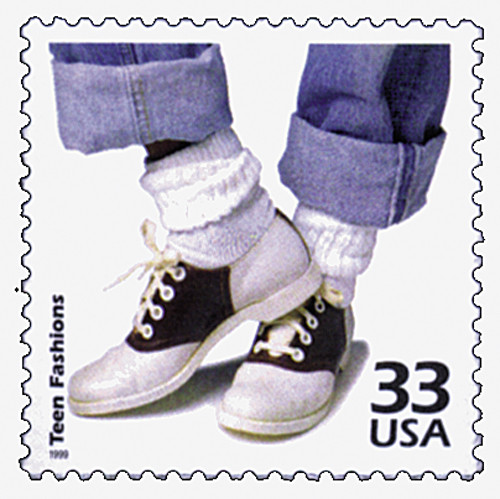
# 3187f - 1999 33c Celebrate the Century - 1950s: Public School Desegregation
US #3187f
1999 Desegregating Public Schools – Celebrate the Century (1950s)
• Part of the sixth sheet in the Celebrate the Century stamp series issued from 1998-2000
• Commemorates the desegregation of public schools
• Includes text on the back with historical details
Stamp Category: Commemorative
Series: Celebrate the Century
Value: 32¢ First Class Mail Rate
First Day of Issue: May 26, 1999
First Day City: Springfield, Massachusetts
Quantity Issued: 188,000,000
Printed by: Ashton Potter (USA) Ltd.
Printing Method: Offset, Intaglio
Format: Panes of 15
Perforations: 11.5
Tagging: Block Tagging
Why the stamp was issued: To honor the landmark Brown vs. Board of Education court case and its verdict which led to the elimination of segregation in public schools throughout the United States.
About the stamp design: Pictures artwork by Dean Ellis of three children of different races reciting the Pledge of Allegiance in school. Includes the following text on the back: “With Brown v. Board of Education of Topeka, Kansas (1954), the US Supreme Court declared racial separation in public education unconstitutional. The ruling initated the beginning of mandatory integration of public schools.”
First Day City: The First Day of Issue Ceremony was held at the Civic Center in Springfield, Massachusetts, the hometown of Dr. Seuss.
About the Celebrate the Century series: The USPS launched the Celebrate the Century series in 1998 to mark the end of the 20th century and herald the arrival of the 21st. The series includes 10 sheets of 15 stamps (150 in total), with each honoring important moments from a different decade (1900s, 10s, 20s, 30s, 40s, 50s, 60s, 70s, 80s, and 90s). At the time of completion, it was the longest and most ambitious commemorative stamp series in US history.
History the stamp represents: In 1951, Oliver Brown took the Topeka, Kansas Board of Education to court for refusing his daughter, Linda, admission to an all-white school. Thurgood Marshall, who later became the first black justice of the US Supreme Court, presented Brown’s case.
When Brown vs. Board of Education of Topeka reached the Supreme Court in 1954, it concluded that “in the field of public opinion, the doctrine of separate but equal has no place. Separated educational facilities are inherently unequal.” With these words, the Court outlawed racial segregation.
Opposition to the verdict was fierce. Many white southern Congress members signed the “Southern Manifesto,” condemning the case and declaring the states had the right to ignore it. To avoid desegregation, some officials closed their local public schools.
Three years after the court’s decision, not one southern child attended a desegregated school. That changed in September 1957, when Little Rock’s Central High School was forced to allow nine black students to attend classes there. Governor Orval Faubus prevented their admission for over three weeks. After much tension and unrest, the students were escorted into the school by National Guard units on September 25.
US #3187f
1999 Desegregating Public Schools – Celebrate the Century (1950s)
• Part of the sixth sheet in the Celebrate the Century stamp series issued from 1998-2000
• Commemorates the desegregation of public schools
• Includes text on the back with historical details
Stamp Category: Commemorative
Series: Celebrate the Century
Value: 32¢ First Class Mail Rate
First Day of Issue: May 26, 1999
First Day City: Springfield, Massachusetts
Quantity Issued: 188,000,000
Printed by: Ashton Potter (USA) Ltd.
Printing Method: Offset, Intaglio
Format: Panes of 15
Perforations: 11.5
Tagging: Block Tagging
Why the stamp was issued: To honor the landmark Brown vs. Board of Education court case and its verdict which led to the elimination of segregation in public schools throughout the United States.
About the stamp design: Pictures artwork by Dean Ellis of three children of different races reciting the Pledge of Allegiance in school. Includes the following text on the back: “With Brown v. Board of Education of Topeka, Kansas (1954), the US Supreme Court declared racial separation in public education unconstitutional. The ruling initated the beginning of mandatory integration of public schools.”
First Day City: The First Day of Issue Ceremony was held at the Civic Center in Springfield, Massachusetts, the hometown of Dr. Seuss.
About the Celebrate the Century series: The USPS launched the Celebrate the Century series in 1998 to mark the end of the 20th century and herald the arrival of the 21st. The series includes 10 sheets of 15 stamps (150 in total), with each honoring important moments from a different decade (1900s, 10s, 20s, 30s, 40s, 50s, 60s, 70s, 80s, and 90s). At the time of completion, it was the longest and most ambitious commemorative stamp series in US history.
History the stamp represents: In 1951, Oliver Brown took the Topeka, Kansas Board of Education to court for refusing his daughter, Linda, admission to an all-white school. Thurgood Marshall, who later became the first black justice of the US Supreme Court, presented Brown’s case.
When Brown vs. Board of Education of Topeka reached the Supreme Court in 1954, it concluded that “in the field of public opinion, the doctrine of separate but equal has no place. Separated educational facilities are inherently unequal.” With these words, the Court outlawed racial segregation.
Opposition to the verdict was fierce. Many white southern Congress members signed the “Southern Manifesto,” condemning the case and declaring the states had the right to ignore it. To avoid desegregation, some officials closed their local public schools.
Three years after the court’s decision, not one southern child attended a desegregated school. That changed in September 1957, when Little Rock’s Central High School was forced to allow nine black students to attend classes there. Governor Orval Faubus prevented their admission for over three weeks. After much tension and unrest, the students were escorted into the school by National Guard units on September 25.













